Research Proposal: PsyCap's Impact on Employee Retention at MoHRE UAE
VerifiedAdded on 2022/02/15
|29
|8795
|471
Project
AI Summary
This research proposal, submitted for a Doctor of Business Administration, investigates the impact of psychological capital (PsyCap) factors on employee retention at the Ministry of Human Resources and Emiratization (MoHRE) in the United Arab Emirates. The study focuses on the HERO model, encompassing hope, efficacy, resilience, and optimism, and their influence on employee turnover. The proposal includes a comprehensive literature review, examining the existing research on PsyCap, its components, and its relation to employee attitudes and behaviors. The methodology outlines the research design, ethical considerations, population, and sample selection, along with data collection and analysis methods. The proposal also addresses project management, including time and cost estimations, and highlights the research's novelty and relevance to the field of human resources management and industrial and organizational psychology. The findings are intended to inform HR professionals and contribute to the development of leadership practices that enhance employee retention.
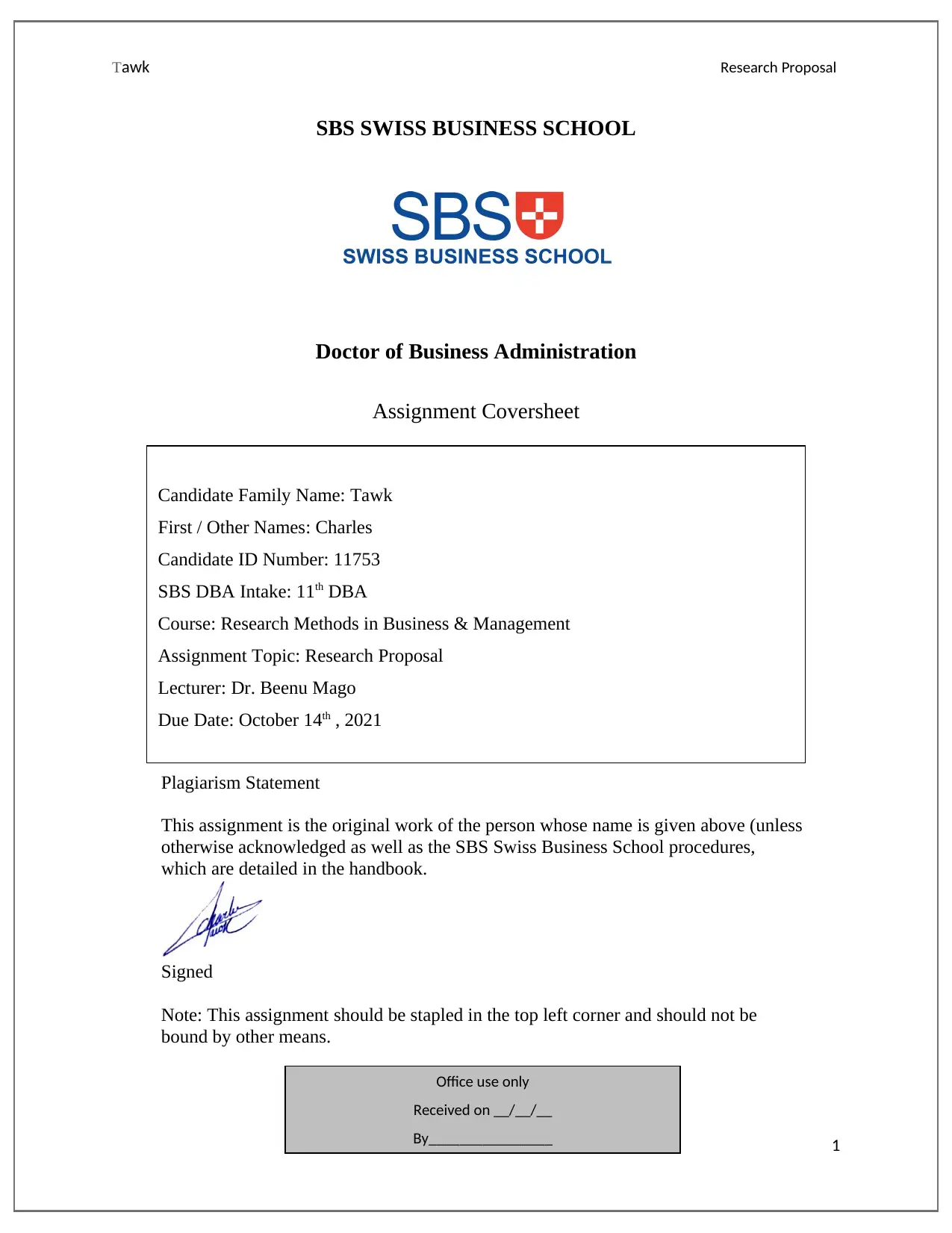
Tawk Research Proposal
SBS SWISS BUSINESS SCHOOL
Doctor of Business Administration
Assignment Coversheet
Plagiarism Statement
This assignment is the original work of the person whose name is given above (unless
otherwise acknowledged as well as the SBS Swiss Business School procedures,
which are detailed in the handbook.
Signed
Note: This assignment should be stapled in the top left corner and should not be
bound by other means.
1
Candidate Family Name: Tawk
First / Other Names: Charles
Candidate ID Number: 11753
SBS DBA Intake: 11th DBA
Course: Research Methods in Business & Management
Assignment Topic: Research Proposal
Lecturer: Dr. Beenu Mago
Due Date: October 14th , 2021
Office use only
Received on __/__/__
By________________
SBS SWISS BUSINESS SCHOOL
Doctor of Business Administration
Assignment Coversheet
Plagiarism Statement
This assignment is the original work of the person whose name is given above (unless
otherwise acknowledged as well as the SBS Swiss Business School procedures,
which are detailed in the handbook.
Signed
Note: This assignment should be stapled in the top left corner and should not be
bound by other means.
1
Candidate Family Name: Tawk
First / Other Names: Charles
Candidate ID Number: 11753
SBS DBA Intake: 11th DBA
Course: Research Methods in Business & Management
Assignment Topic: Research Proposal
Lecturer: Dr. Beenu Mago
Due Date: October 14th , 2021
Office use only
Received on __/__/__
By________________
Paraphrase This Document
Need a fresh take? Get an instant paraphrase of this document with our AI Paraphraser
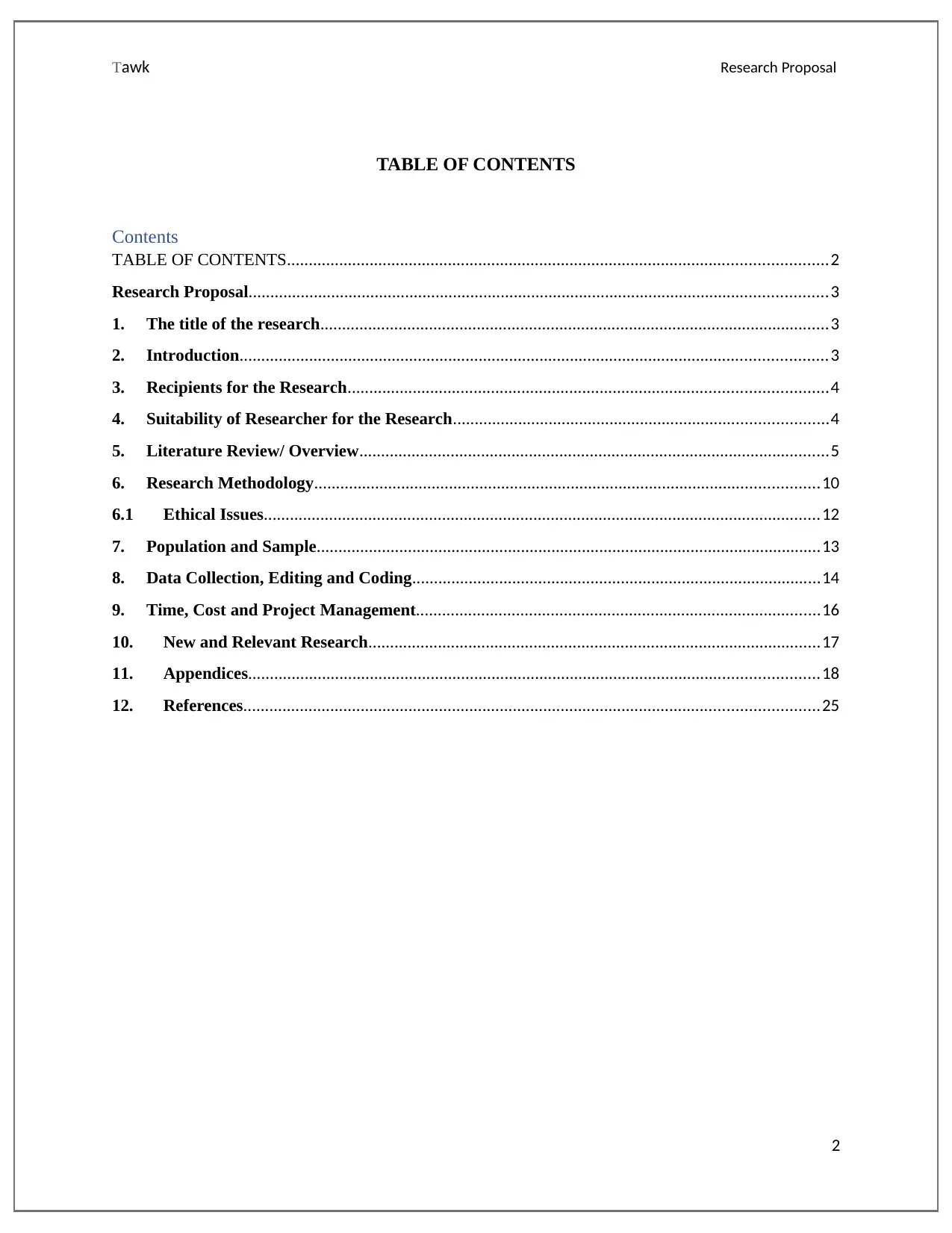
Tawk Research Proposal
TABLE OF CONTENTS
Contents
TABLE OF CONTENTS............................................................................................................................2
Research Proposal.....................................................................................................................................3
1. The title of the research.....................................................................................................................3
2. Introduction.......................................................................................................................................3
3. Recipients for the Research..............................................................................................................4
4. Suitability of Researcher for the Research......................................................................................4
5. Literature Review/ Overview............................................................................................................5
6. Research Methodology....................................................................................................................10
6.1 Ethical Issues................................................................................................................................12
7. Population and Sample....................................................................................................................13
8. Data Collection, Editing and Coding..............................................................................................14
9. Time, Cost and Project Management.............................................................................................16
10. New and Relevant Research........................................................................................................17
11. Appendices...................................................................................................................................18
12. References....................................................................................................................................25
2
TABLE OF CONTENTS
Contents
TABLE OF CONTENTS............................................................................................................................2
Research Proposal.....................................................................................................................................3
1. The title of the research.....................................................................................................................3
2. Introduction.......................................................................................................................................3
3. Recipients for the Research..............................................................................................................4
4. Suitability of Researcher for the Research......................................................................................4
5. Literature Review/ Overview............................................................................................................5
6. Research Methodology....................................................................................................................10
6.1 Ethical Issues................................................................................................................................12
7. Population and Sample....................................................................................................................13
8. Data Collection, Editing and Coding..............................................................................................14
9. Time, Cost and Project Management.............................................................................................16
10. New and Relevant Research........................................................................................................17
11. Appendices...................................................................................................................................18
12. References....................................................................................................................................25
2
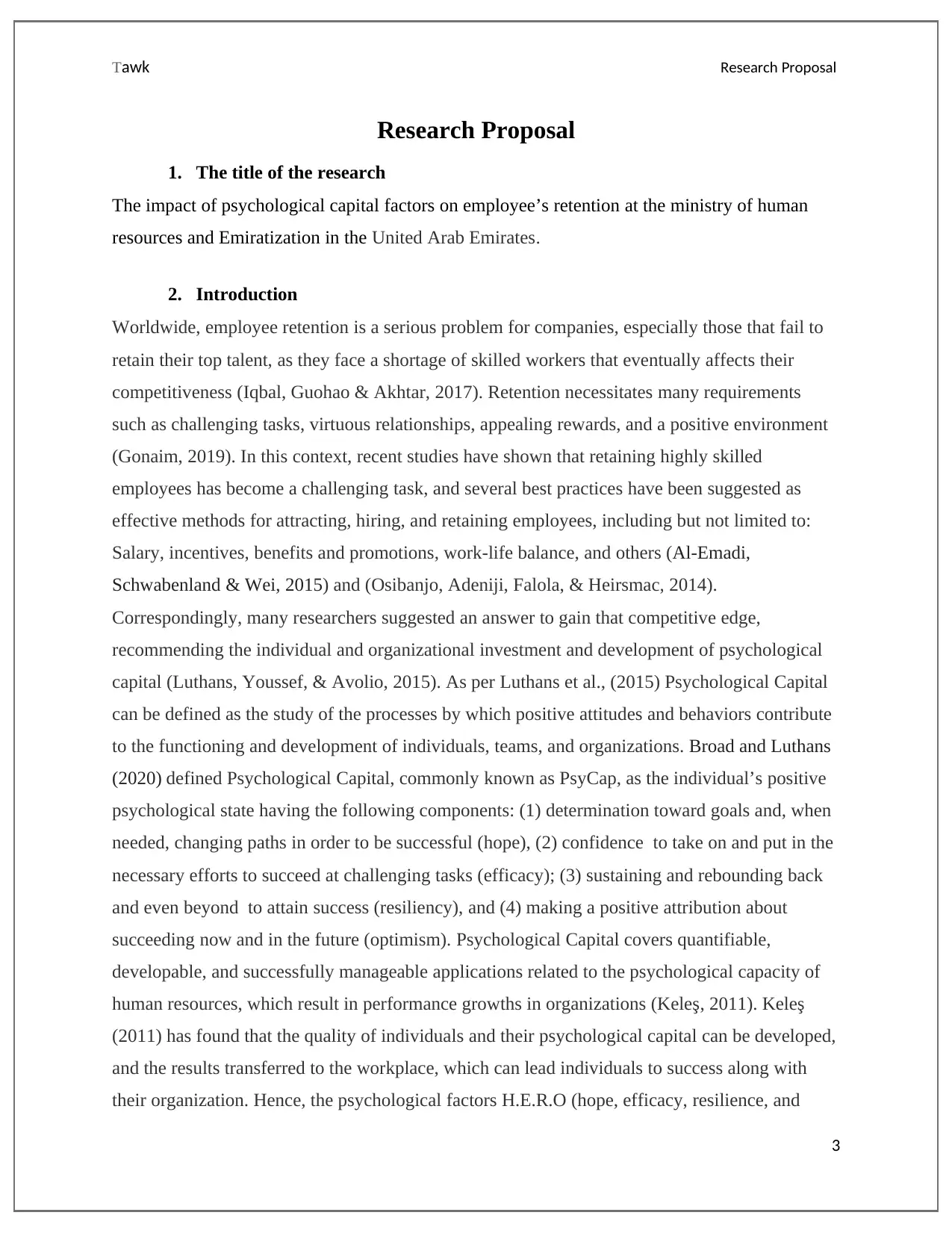
Tawk Research Proposal
Research Proposal
1. The title of the research
The impact of psychological capital factors on employee’s retention at the ministry of human
resources and Emiratization in the United Arab Emirates.
2. Introduction
Worldwide, employee retention is a serious problem for companies, especially those that fail to
retain their top talent, as they face a shortage of skilled workers that eventually affects their
competitiveness (Iqbal, Guohao & Akhtar, 2017). Retention necessitates many requirements
such as challenging tasks, virtuous relationships, appealing rewards, and a positive environment
(Gonaim, 2019). In this context, recent studies have shown that retaining highly skilled
employees has become a challenging task, and several best practices have been suggested as
effective methods for attracting, hiring, and retaining employees, including but not limited to:
Salary, incentives, benefits and promotions, work-life balance, and others (Al-Emadi,
Schwabenland & Wei, 2015) and (Osibanjo, Adeniji, Falola, & Heirsmac, 2014).
Correspondingly, many researchers suggested an answer to gain that competitive edge,
recommending the individual and organizational investment and development of psychological
capital (Luthans, Youssef, & Avolio, 2015). As per Luthans et al., (2015) Psychological Capital
can be defined as the study of the processes by which positive attitudes and behaviors contribute
to the functioning and development of individuals, teams, and organizations. Broad and Luthans
(2020) defined Psychological Capital, commonly known as PsyCap, as the individual’s positive
psychological state having the following components: (1) determination toward goals and, when
needed, changing paths in order to be successful (hope), (2) confidence to take on and put in the
necessary efforts to succeed at challenging tasks (efficacy); (3) sustaining and rebounding back
and even beyond to attain success (resiliency), and (4) making a positive attribution about
succeeding now and in the future (optimism). Psychological Capital covers quantifiable,
developable, and successfully manageable applications related to the psychological capacity of
human resources, which result in performance growths in organizations (Keleş, 2011). Keleş
(2011) has found that the quality of individuals and their psychological capital can be developed,
and the results transferred to the workplace, which can lead individuals to success along with
their organization. Hence, the psychological factors H.E.R.O (hope, efficacy, resilience, and
3
Research Proposal
1. The title of the research
The impact of psychological capital factors on employee’s retention at the ministry of human
resources and Emiratization in the United Arab Emirates.
2. Introduction
Worldwide, employee retention is a serious problem for companies, especially those that fail to
retain their top talent, as they face a shortage of skilled workers that eventually affects their
competitiveness (Iqbal, Guohao & Akhtar, 2017). Retention necessitates many requirements
such as challenging tasks, virtuous relationships, appealing rewards, and a positive environment
(Gonaim, 2019). In this context, recent studies have shown that retaining highly skilled
employees has become a challenging task, and several best practices have been suggested as
effective methods for attracting, hiring, and retaining employees, including but not limited to:
Salary, incentives, benefits and promotions, work-life balance, and others (Al-Emadi,
Schwabenland & Wei, 2015) and (Osibanjo, Adeniji, Falola, & Heirsmac, 2014).
Correspondingly, many researchers suggested an answer to gain that competitive edge,
recommending the individual and organizational investment and development of psychological
capital (Luthans, Youssef, & Avolio, 2015). As per Luthans et al., (2015) Psychological Capital
can be defined as the study of the processes by which positive attitudes and behaviors contribute
to the functioning and development of individuals, teams, and organizations. Broad and Luthans
(2020) defined Psychological Capital, commonly known as PsyCap, as the individual’s positive
psychological state having the following components: (1) determination toward goals and, when
needed, changing paths in order to be successful (hope), (2) confidence to take on and put in the
necessary efforts to succeed at challenging tasks (efficacy); (3) sustaining and rebounding back
and even beyond to attain success (resiliency), and (4) making a positive attribution about
succeeding now and in the future (optimism). Psychological Capital covers quantifiable,
developable, and successfully manageable applications related to the psychological capacity of
human resources, which result in performance growths in organizations (Keleş, 2011). Keleş
(2011) has found that the quality of individuals and their psychological capital can be developed,
and the results transferred to the workplace, which can lead individuals to success along with
their organization. Hence, the psychological factors H.E.R.O (hope, efficacy, resilience, and
3
⊘ This is a preview!⊘
Do you want full access?
Subscribe today to unlock all pages.

Trusted by 1+ million students worldwide
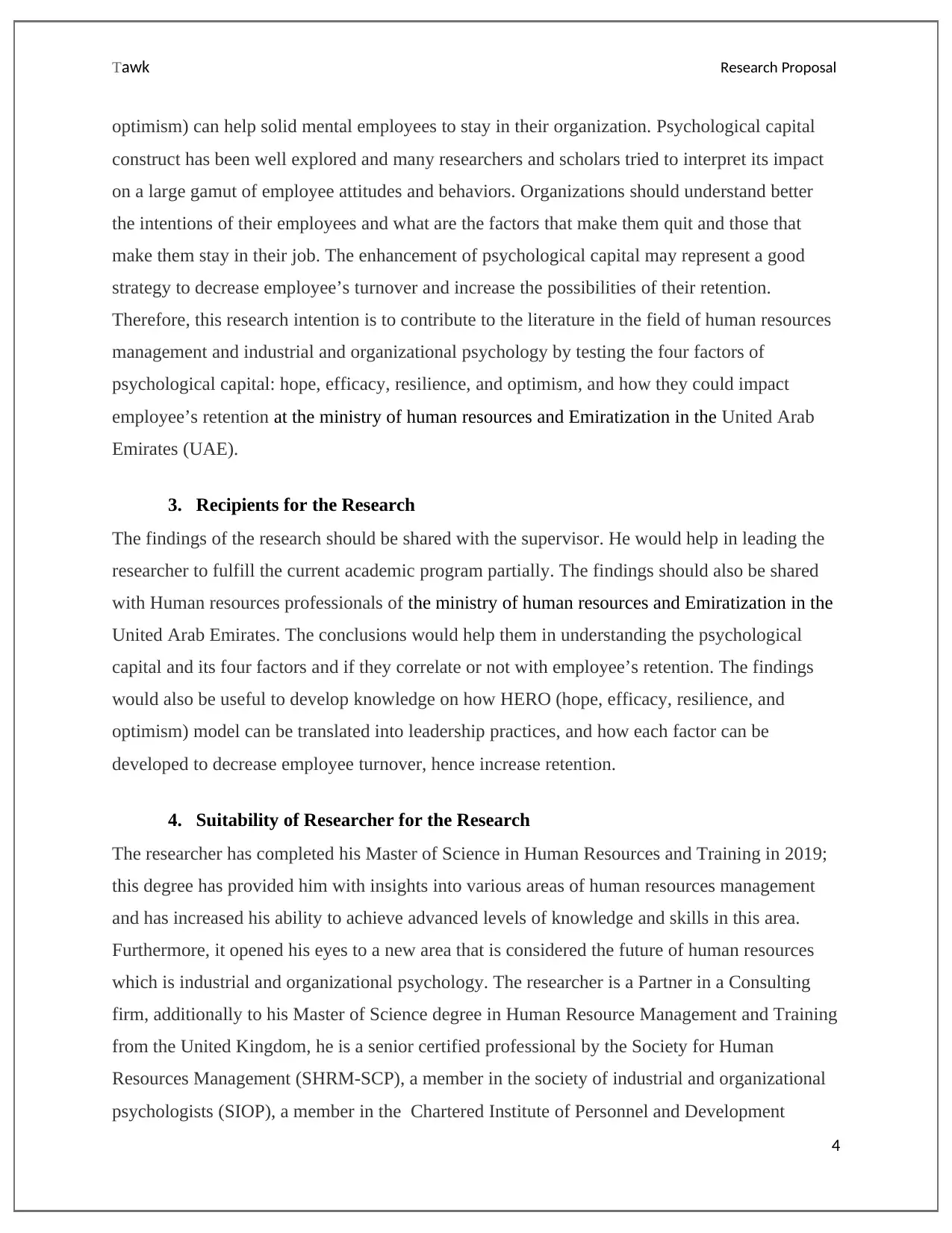
Tawk Research Proposal
optimism) can help solid mental employees to stay in their organization. Psychological capital
construct has been well explored and many researchers and scholars tried to interpret its impact
on a large gamut of employee attitudes and behaviors. Organizations should understand better
the intentions of their employees and what are the factors that make them quit and those that
make them stay in their job. The enhancement of psychological capital may represent a good
strategy to decrease employee’s turnover and increase the possibilities of their retention.
Therefore, this research intention is to contribute to the literature in the field of human resources
management and industrial and organizational psychology by testing the four factors of
psychological capital: hope, efficacy, resilience, and optimism, and how they could impact
employee’s retention at the ministry of human resources and Emiratization in the United Arab
Emirates (UAE).
3. Recipients for the Research
The findings of the research should be shared with the supervisor. He would help in leading the
researcher to fulfill the current academic program partially. The findings should also be shared
with Human resources professionals of the ministry of human resources and Emiratization in the
United Arab Emirates. The conclusions would help them in understanding the psychological
capital and its four factors and if they correlate or not with employee’s retention. The findings
would also be useful to develop knowledge on how HERO (hope, efficacy, resilience, and
optimism) model can be translated into leadership practices, and how each factor can be
developed to decrease employee turnover, hence increase retention.
4. Suitability of Researcher for the Research
The researcher has completed his Master of Science in Human Resources and Training in 2019;
this degree has provided him with insights into various areas of human resources management
and has increased his ability to achieve advanced levels of knowledge and skills in this area.
Furthermore, it opened his eyes to a new area that is considered the future of human resources
which is industrial and organizational psychology. The researcher is a Partner in a Consulting
firm, additionally to his Master of Science degree in Human Resource Management and Training
from the United Kingdom, he is a senior certified professional by the Society for Human
Resources Management (SHRM-SCP), a member in the society of industrial and organizational
psychologists (SIOP), a member in the Chartered Institute of Personnel and Development
4
optimism) can help solid mental employees to stay in their organization. Psychological capital
construct has been well explored and many researchers and scholars tried to interpret its impact
on a large gamut of employee attitudes and behaviors. Organizations should understand better
the intentions of their employees and what are the factors that make them quit and those that
make them stay in their job. The enhancement of psychological capital may represent a good
strategy to decrease employee’s turnover and increase the possibilities of their retention.
Therefore, this research intention is to contribute to the literature in the field of human resources
management and industrial and organizational psychology by testing the four factors of
psychological capital: hope, efficacy, resilience, and optimism, and how they could impact
employee’s retention at the ministry of human resources and Emiratization in the United Arab
Emirates (UAE).
3. Recipients for the Research
The findings of the research should be shared with the supervisor. He would help in leading the
researcher to fulfill the current academic program partially. The findings should also be shared
with Human resources professionals of the ministry of human resources and Emiratization in the
United Arab Emirates. The conclusions would help them in understanding the psychological
capital and its four factors and if they correlate or not with employee’s retention. The findings
would also be useful to develop knowledge on how HERO (hope, efficacy, resilience, and
optimism) model can be translated into leadership practices, and how each factor can be
developed to decrease employee turnover, hence increase retention.
4. Suitability of Researcher for the Research
The researcher has completed his Master of Science in Human Resources and Training in 2019;
this degree has provided him with insights into various areas of human resources management
and has increased his ability to achieve advanced levels of knowledge and skills in this area.
Furthermore, it opened his eyes to a new area that is considered the future of human resources
which is industrial and organizational psychology. The researcher is a Partner in a Consulting
firm, additionally to his Master of Science degree in Human Resource Management and Training
from the United Kingdom, he is a senior certified professional by the Society for Human
Resources Management (SHRM-SCP), a member in the society of industrial and organizational
psychologists (SIOP), a member in the Chartered Institute of Personnel and Development
4
Paraphrase This Document
Need a fresh take? Get an instant paraphrase of this document with our AI Paraphraser
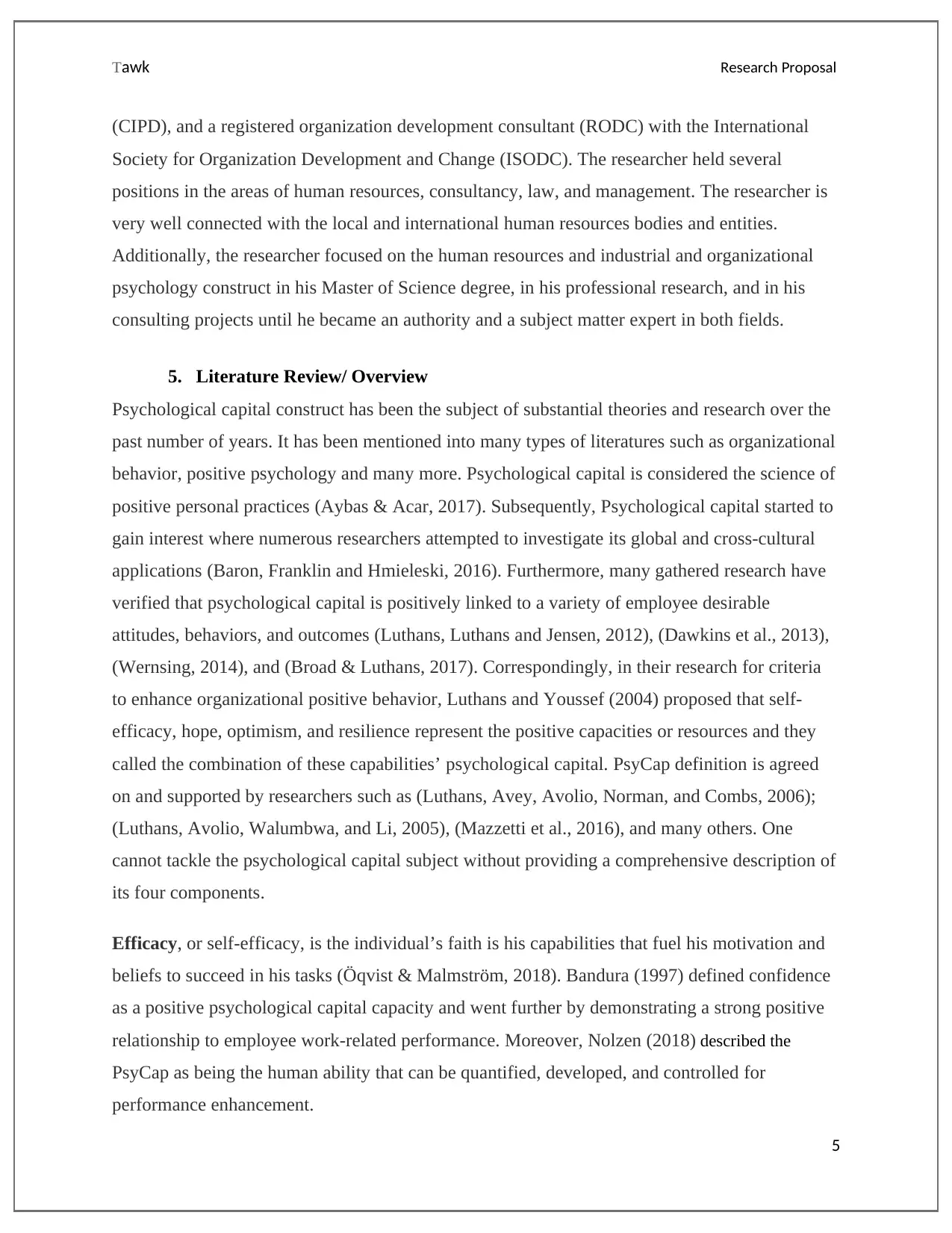
Tawk Research Proposal
(CIPD), and a registered organization development consultant (RODC) with the International
Society for Organization Development and Change (ISODC). The researcher held several
positions in the areas of human resources, consultancy, law, and management. The researcher is
very well connected with the local and international human resources bodies and entities.
Additionally, the researcher focused on the human resources and industrial and organizational
psychology construct in his Master of Science degree, in his professional research, and in his
consulting projects until he became an authority and a subject matter expert in both fields.
5. Literature Review/ Overview
Psychological capital construct has been the subject of substantial theories and research over the
past number of years. It has been mentioned into many types of literatures such as organizational
behavior, positive psychology and many more. Psychological capital is considered the science of
positive personal practices (Aybas & Acar, 2017). Subsequently, Psychological capital started to
gain interest where numerous researchers attempted to investigate its global and cross-cultural
applications (Baron, Franklin and Hmieleski, 2016). Furthermore, many gathered research have
verified that psychological capital is positively linked to a variety of employee desirable
attitudes, behaviors, and outcomes (Luthans, Luthans and Jensen, 2012), (Dawkins et al., 2013),
(Wernsing, 2014), and (Broad & Luthans, 2017). Correspondingly, in their research for criteria
to enhance organizational positive behavior, Luthans and Youssef (2004) proposed that self-
efficacy, hope, optimism, and resilience represent the positive capacities or resources and they
called the combination of these capabilities’ psychological capital. PsyCap definition is agreed
on and supported by researchers such as (Luthans, Avey, Avolio, Norman, and Combs, 2006);
(Luthans, Avolio, Walumbwa, and Li, 2005), (Mazzetti et al., 2016), and many others. One
cannot tackle the psychological capital subject without providing a comprehensive description of
its four components.
Efficacy, or self-efficacy, is the individual’s faith is his capabilities that fuel his motivation and
beliefs to succeed in his tasks (Öqvist & Malmström, 2018). Bandura (1997) defined confidence
as a positive psychological capital capacity and went further by demonstrating a strong positive
relationship to employee work-related performance. Moreover, Nolzen (2018) described the
PsyCap as being the human ability that can be quantified, developed, and controlled for
performance enhancement.
5
(CIPD), and a registered organization development consultant (RODC) with the International
Society for Organization Development and Change (ISODC). The researcher held several
positions in the areas of human resources, consultancy, law, and management. The researcher is
very well connected with the local and international human resources bodies and entities.
Additionally, the researcher focused on the human resources and industrial and organizational
psychology construct in his Master of Science degree, in his professional research, and in his
consulting projects until he became an authority and a subject matter expert in both fields.
5. Literature Review/ Overview
Psychological capital construct has been the subject of substantial theories and research over the
past number of years. It has been mentioned into many types of literatures such as organizational
behavior, positive psychology and many more. Psychological capital is considered the science of
positive personal practices (Aybas & Acar, 2017). Subsequently, Psychological capital started to
gain interest where numerous researchers attempted to investigate its global and cross-cultural
applications (Baron, Franklin and Hmieleski, 2016). Furthermore, many gathered research have
verified that psychological capital is positively linked to a variety of employee desirable
attitudes, behaviors, and outcomes (Luthans, Luthans and Jensen, 2012), (Dawkins et al., 2013),
(Wernsing, 2014), and (Broad & Luthans, 2017). Correspondingly, in their research for criteria
to enhance organizational positive behavior, Luthans and Youssef (2004) proposed that self-
efficacy, hope, optimism, and resilience represent the positive capacities or resources and they
called the combination of these capabilities’ psychological capital. PsyCap definition is agreed
on and supported by researchers such as (Luthans, Avey, Avolio, Norman, and Combs, 2006);
(Luthans, Avolio, Walumbwa, and Li, 2005), (Mazzetti et al., 2016), and many others. One
cannot tackle the psychological capital subject without providing a comprehensive description of
its four components.
Efficacy, or self-efficacy, is the individual’s faith is his capabilities that fuel his motivation and
beliefs to succeed in his tasks (Öqvist & Malmström, 2018). Bandura (1997) defined confidence
as a positive psychological capital capacity and went further by demonstrating a strong positive
relationship to employee work-related performance. Moreover, Nolzen (2018) described the
PsyCap as being the human ability that can be quantified, developed, and controlled for
performance enhancement.
5
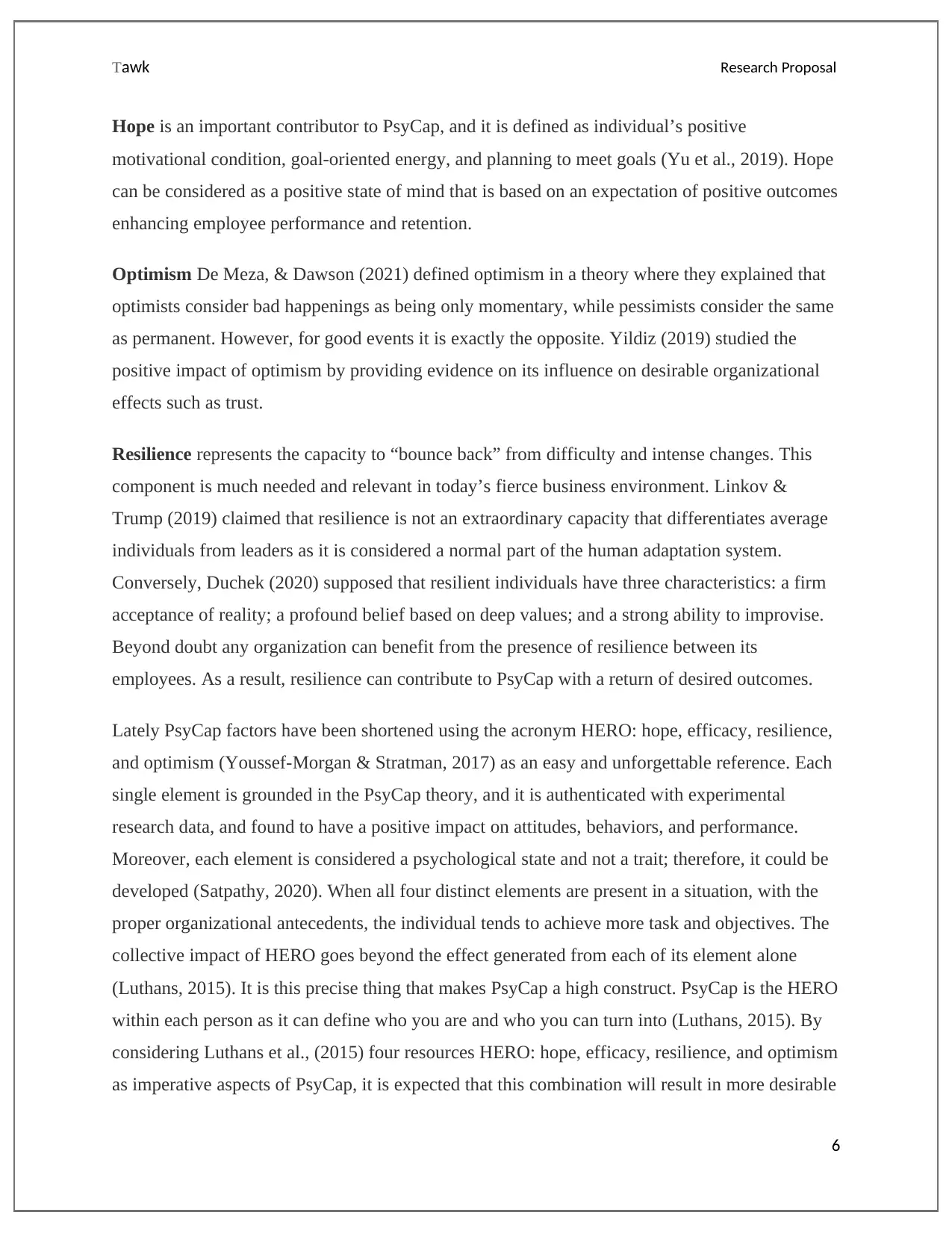
Tawk Research Proposal
Hope is an important contributor to PsyCap, and it is defined as individual’s positive
motivational condition, goal-oriented energy, and planning to meet goals (Yu et al., 2019). Hope
can be considered as a positive state of mind that is based on an expectation of positive outcomes
enhancing employee performance and retention.
Optimism De Meza, & Dawson (2021) defined optimism in a theory where they explained that
optimists consider bad happenings as being only momentary, while pessimists consider the same
as permanent. However, for good events it is exactly the opposite. Yildiz (2019) studied the
positive impact of optimism by providing evidence on its influence on desirable organizational
effects such as trust.
Resilience represents the capacity to “bounce back” from difficulty and intense changes. This
component is much needed and relevant in today’s fierce business environment. Linkov &
Trump (2019) claimed that resilience is not an extraordinary capacity that differentiates average
individuals from leaders as it is considered a normal part of the human adaptation system.
Conversely, Duchek (2020) supposed that resilient individuals have three characteristics: a firm
acceptance of reality; a profound belief based on deep values; and a strong ability to improvise.
Beyond doubt any organization can benefit from the presence of resilience between its
employees. As a result, resilience can contribute to PsyCap with a return of desired outcomes.
Lately PsyCap factors have been shortened using the acronym HERO: hope, efficacy, resilience,
and optimism (Youssef-Morgan & Stratman, 2017) as an easy and unforgettable reference. Each
single element is grounded in the PsyCap theory, and it is authenticated with experimental
research data, and found to have a positive impact on attitudes, behaviors, and performance.
Moreover, each element is considered a psychological state and not a trait; therefore, it could be
developed (Satpathy, 2020). When all four distinct elements are present in a situation, with the
proper organizational antecedents, the individual tends to achieve more task and objectives. The
collective impact of HERO goes beyond the effect generated from each of its element alone
(Luthans, 2015). It is this precise thing that makes PsyCap a high construct. PsyCap is the HERO
within each person as it can define who you are and who you can turn into (Luthans, 2015). By
considering Luthans et al., (2015) four resources HERO: hope, efficacy, resilience, and optimism
as imperative aspects of PsyCap, it is expected that this combination will result in more desirable
6
Hope is an important contributor to PsyCap, and it is defined as individual’s positive
motivational condition, goal-oriented energy, and planning to meet goals (Yu et al., 2019). Hope
can be considered as a positive state of mind that is based on an expectation of positive outcomes
enhancing employee performance and retention.
Optimism De Meza, & Dawson (2021) defined optimism in a theory where they explained that
optimists consider bad happenings as being only momentary, while pessimists consider the same
as permanent. However, for good events it is exactly the opposite. Yildiz (2019) studied the
positive impact of optimism by providing evidence on its influence on desirable organizational
effects such as trust.
Resilience represents the capacity to “bounce back” from difficulty and intense changes. This
component is much needed and relevant in today’s fierce business environment. Linkov &
Trump (2019) claimed that resilience is not an extraordinary capacity that differentiates average
individuals from leaders as it is considered a normal part of the human adaptation system.
Conversely, Duchek (2020) supposed that resilient individuals have three characteristics: a firm
acceptance of reality; a profound belief based on deep values; and a strong ability to improvise.
Beyond doubt any organization can benefit from the presence of resilience between its
employees. As a result, resilience can contribute to PsyCap with a return of desired outcomes.
Lately PsyCap factors have been shortened using the acronym HERO: hope, efficacy, resilience,
and optimism (Youssef-Morgan & Stratman, 2017) as an easy and unforgettable reference. Each
single element is grounded in the PsyCap theory, and it is authenticated with experimental
research data, and found to have a positive impact on attitudes, behaviors, and performance.
Moreover, each element is considered a psychological state and not a trait; therefore, it could be
developed (Satpathy, 2020). When all four distinct elements are present in a situation, with the
proper organizational antecedents, the individual tends to achieve more task and objectives. The
collective impact of HERO goes beyond the effect generated from each of its element alone
(Luthans, 2015). It is this precise thing that makes PsyCap a high construct. PsyCap is the HERO
within each person as it can define who you are and who you can turn into (Luthans, 2015). By
considering Luthans et al., (2015) four resources HERO: hope, efficacy, resilience, and optimism
as imperative aspects of PsyCap, it is expected that this combination will result in more desirable
6
⊘ This is a preview!⊘
Do you want full access?
Subscribe today to unlock all pages.

Trusted by 1+ million students worldwide
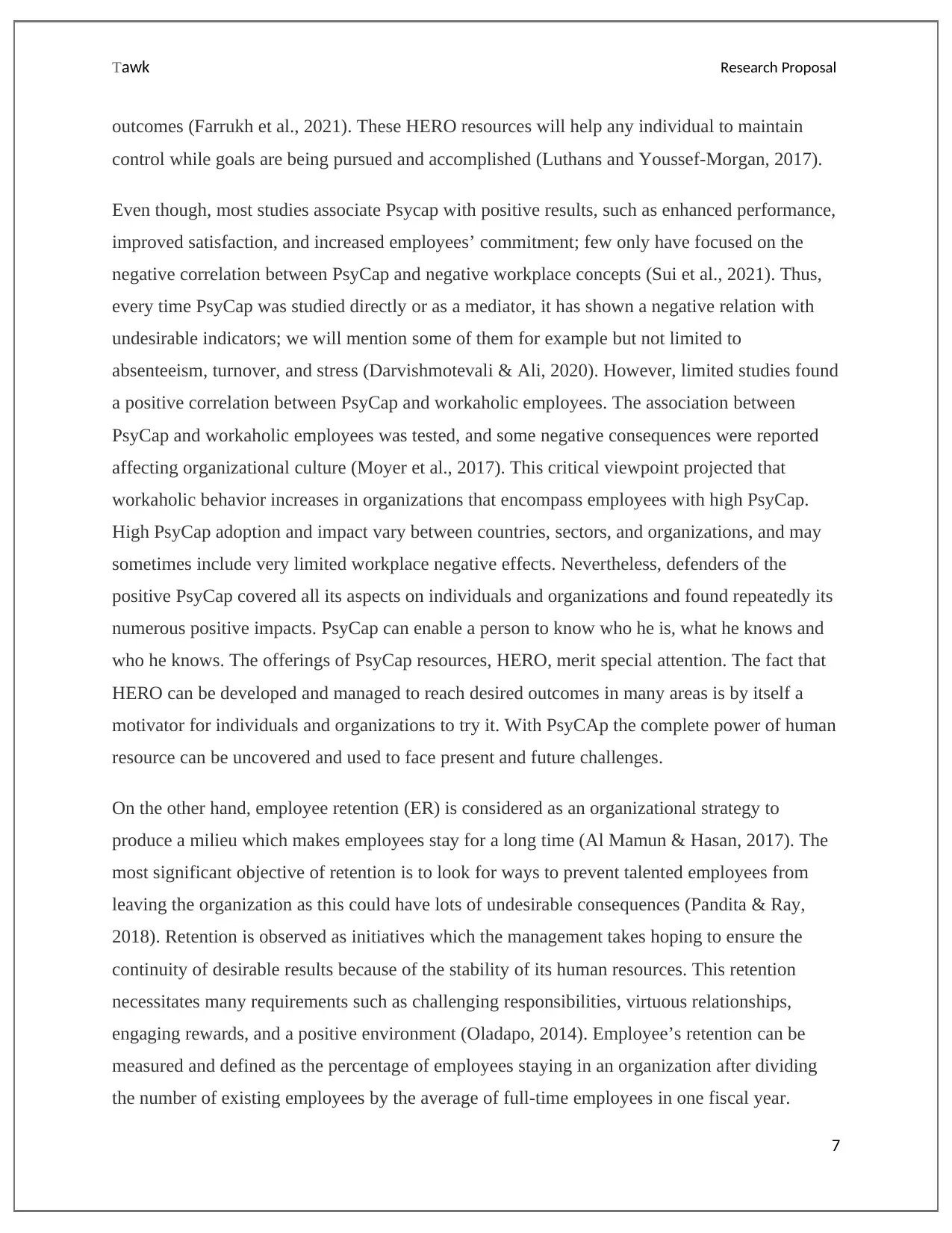
Tawk Research Proposal
outcomes (Farrukh et al., 2021). These HERO resources will help any individual to maintain
control while goals are being pursued and accomplished (Luthans and Youssef-Morgan, 2017).
Even though, most studies associate Psycap with positive results, such as enhanced performance,
improved satisfaction, and increased employees’ commitment; few only have focused on the
negative correlation between PsyCap and negative workplace concepts (Sui et al., 2021). Thus,
every time PsyCap was studied directly or as a mediator, it has shown a negative relation with
undesirable indicators; we will mention some of them for example but not limited to
absenteeism, turnover, and stress (Darvishmotevali & Ali, 2020). However, limited studies found
a positive correlation between PsyCap and workaholic employees. The association between
PsyCap and workaholic employees was tested, and some negative consequences were reported
affecting organizational culture (Moyer et al., 2017). This critical viewpoint projected that
workaholic behavior increases in organizations that encompass employees with high PsyCap.
High PsyCap adoption and impact vary between countries, sectors, and organizations, and may
sometimes include very limited workplace negative effects. Nevertheless, defenders of the
positive PsyCap covered all its aspects on individuals and organizations and found repeatedly its
numerous positive impacts. PsyCap can enable a person to know who he is, what he knows and
who he knows. The offerings of PsyCap resources, HERO, merit special attention. The fact that
HERO can be developed and managed to reach desired outcomes in many areas is by itself a
motivator for individuals and organizations to try it. With PsyCAp the complete power of human
resource can be uncovered and used to face present and future challenges.
On the other hand, employee retention (ER) is considered as an organizational strategy to
produce a milieu which makes employees stay for a long time (Al Mamun & Hasan, 2017). The
most significant objective of retention is to look for ways to prevent talented employees from
leaving the organization as this could have lots of undesirable consequences (Pandita & Ray,
2018). Retention is observed as initiatives which the management takes hoping to ensure the
continuity of desirable results because of the stability of its human resources. This retention
necessitates many requirements such as challenging responsibilities, virtuous relationships,
engaging rewards, and a positive environment (Oladapo, 2014). Employee’s retention can be
measured and defined as the percentage of employees staying in an organization after dividing
the number of existing employees by the average of full-time employees in one fiscal year.
7
outcomes (Farrukh et al., 2021). These HERO resources will help any individual to maintain
control while goals are being pursued and accomplished (Luthans and Youssef-Morgan, 2017).
Even though, most studies associate Psycap with positive results, such as enhanced performance,
improved satisfaction, and increased employees’ commitment; few only have focused on the
negative correlation between PsyCap and negative workplace concepts (Sui et al., 2021). Thus,
every time PsyCap was studied directly or as a mediator, it has shown a negative relation with
undesirable indicators; we will mention some of them for example but not limited to
absenteeism, turnover, and stress (Darvishmotevali & Ali, 2020). However, limited studies found
a positive correlation between PsyCap and workaholic employees. The association between
PsyCap and workaholic employees was tested, and some negative consequences were reported
affecting organizational culture (Moyer et al., 2017). This critical viewpoint projected that
workaholic behavior increases in organizations that encompass employees with high PsyCap.
High PsyCap adoption and impact vary between countries, sectors, and organizations, and may
sometimes include very limited workplace negative effects. Nevertheless, defenders of the
positive PsyCap covered all its aspects on individuals and organizations and found repeatedly its
numerous positive impacts. PsyCap can enable a person to know who he is, what he knows and
who he knows. The offerings of PsyCap resources, HERO, merit special attention. The fact that
HERO can be developed and managed to reach desired outcomes in many areas is by itself a
motivator for individuals and organizations to try it. With PsyCAp the complete power of human
resource can be uncovered and used to face present and future challenges.
On the other hand, employee retention (ER) is considered as an organizational strategy to
produce a milieu which makes employees stay for a long time (Al Mamun & Hasan, 2017). The
most significant objective of retention is to look for ways to prevent talented employees from
leaving the organization as this could have lots of undesirable consequences (Pandita & Ray,
2018). Retention is observed as initiatives which the management takes hoping to ensure the
continuity of desirable results because of the stability of its human resources. This retention
necessitates many requirements such as challenging responsibilities, virtuous relationships,
engaging rewards, and a positive environment (Oladapo, 2014). Employee’s retention can be
measured and defined as the percentage of employees staying in an organization after dividing
the number of existing employees by the average of full-time employees in one fiscal year.
7
Paraphrase This Document
Need a fresh take? Get an instant paraphrase of this document with our AI Paraphraser
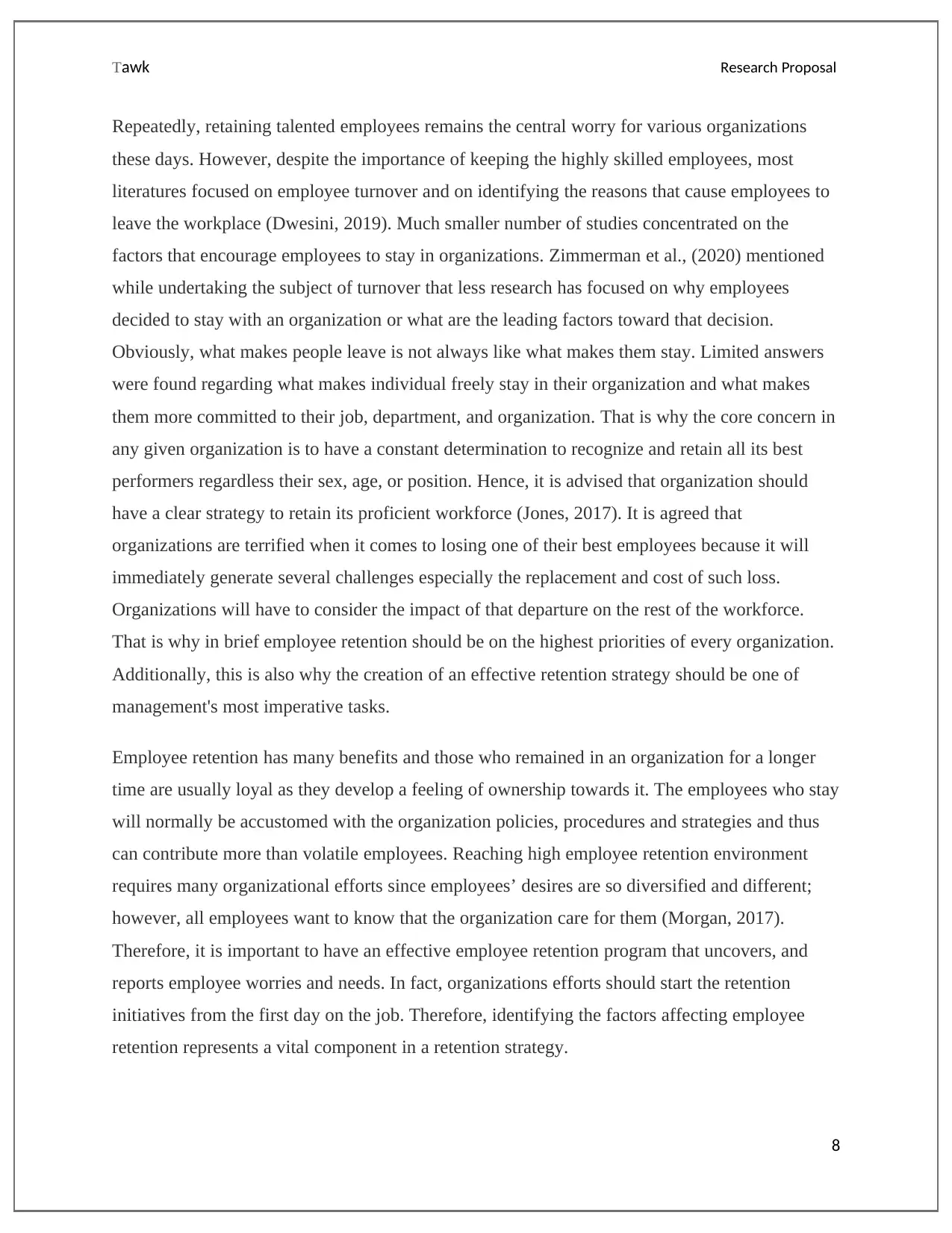
Tawk Research Proposal
Repeatedly, retaining talented employees remains the central worry for various organizations
these days. However, despite the importance of keeping the highly skilled employees, most
literatures focused on employee turnover and on identifying the reasons that cause employees to
leave the workplace (Dwesini, 2019). Much smaller number of studies concentrated on the
factors that encourage employees to stay in organizations. Zimmerman et al., (2020) mentioned
while undertaking the subject of turnover that less research has focused on why employees
decided to stay with an organization or what are the leading factors toward that decision.
Obviously, what makes people leave is not always like what makes them stay. Limited answers
were found regarding what makes individual freely stay in their organization and what makes
them more committed to their job, department, and organization. That is why the core concern in
any given organization is to have a constant determination to recognize and retain all its best
performers regardless their sex, age, or position. Hence, it is advised that organization should
have a clear strategy to retain its proficient workforce (Jones, 2017). It is agreed that
organizations are terrified when it comes to losing one of their best employees because it will
immediately generate several challenges especially the replacement and cost of such loss.
Organizations will have to consider the impact of that departure on the rest of the workforce.
That is why in brief employee retention should be on the highest priorities of every organization.
Additionally, this is also why the creation of an effective retention strategy should be one of
management's most imperative tasks.
Employee retention has many benefits and those who remained in an organization for a longer
time are usually loyal as they develop a feeling of ownership towards it. The employees who stay
will normally be accustomed with the organization policies, procedures and strategies and thus
can contribute more than volatile employees. Reaching high employee retention environment
requires many organizational efforts since employees’ desires are so diversified and different;
however, all employees want to know that the organization care for them (Morgan, 2017).
Therefore, it is important to have an effective employee retention program that uncovers, and
reports employee worries and needs. In fact, organizations efforts should start the retention
initiatives from the first day on the job. Therefore, identifying the factors affecting employee
retention represents a vital component in a retention strategy.
8
Repeatedly, retaining talented employees remains the central worry for various organizations
these days. However, despite the importance of keeping the highly skilled employees, most
literatures focused on employee turnover and on identifying the reasons that cause employees to
leave the workplace (Dwesini, 2019). Much smaller number of studies concentrated on the
factors that encourage employees to stay in organizations. Zimmerman et al., (2020) mentioned
while undertaking the subject of turnover that less research has focused on why employees
decided to stay with an organization or what are the leading factors toward that decision.
Obviously, what makes people leave is not always like what makes them stay. Limited answers
were found regarding what makes individual freely stay in their organization and what makes
them more committed to their job, department, and organization. That is why the core concern in
any given organization is to have a constant determination to recognize and retain all its best
performers regardless their sex, age, or position. Hence, it is advised that organization should
have a clear strategy to retain its proficient workforce (Jones, 2017). It is agreed that
organizations are terrified when it comes to losing one of their best employees because it will
immediately generate several challenges especially the replacement and cost of such loss.
Organizations will have to consider the impact of that departure on the rest of the workforce.
That is why in brief employee retention should be on the highest priorities of every organization.
Additionally, this is also why the creation of an effective retention strategy should be one of
management's most imperative tasks.
Employee retention has many benefits and those who remained in an organization for a longer
time are usually loyal as they develop a feeling of ownership towards it. The employees who stay
will normally be accustomed with the organization policies, procedures and strategies and thus
can contribute more than volatile employees. Reaching high employee retention environment
requires many organizational efforts since employees’ desires are so diversified and different;
however, all employees want to know that the organization care for them (Morgan, 2017).
Therefore, it is important to have an effective employee retention program that uncovers, and
reports employee worries and needs. In fact, organizations efforts should start the retention
initiatives from the first day on the job. Therefore, identifying the factors affecting employee
retention represents a vital component in a retention strategy.
8
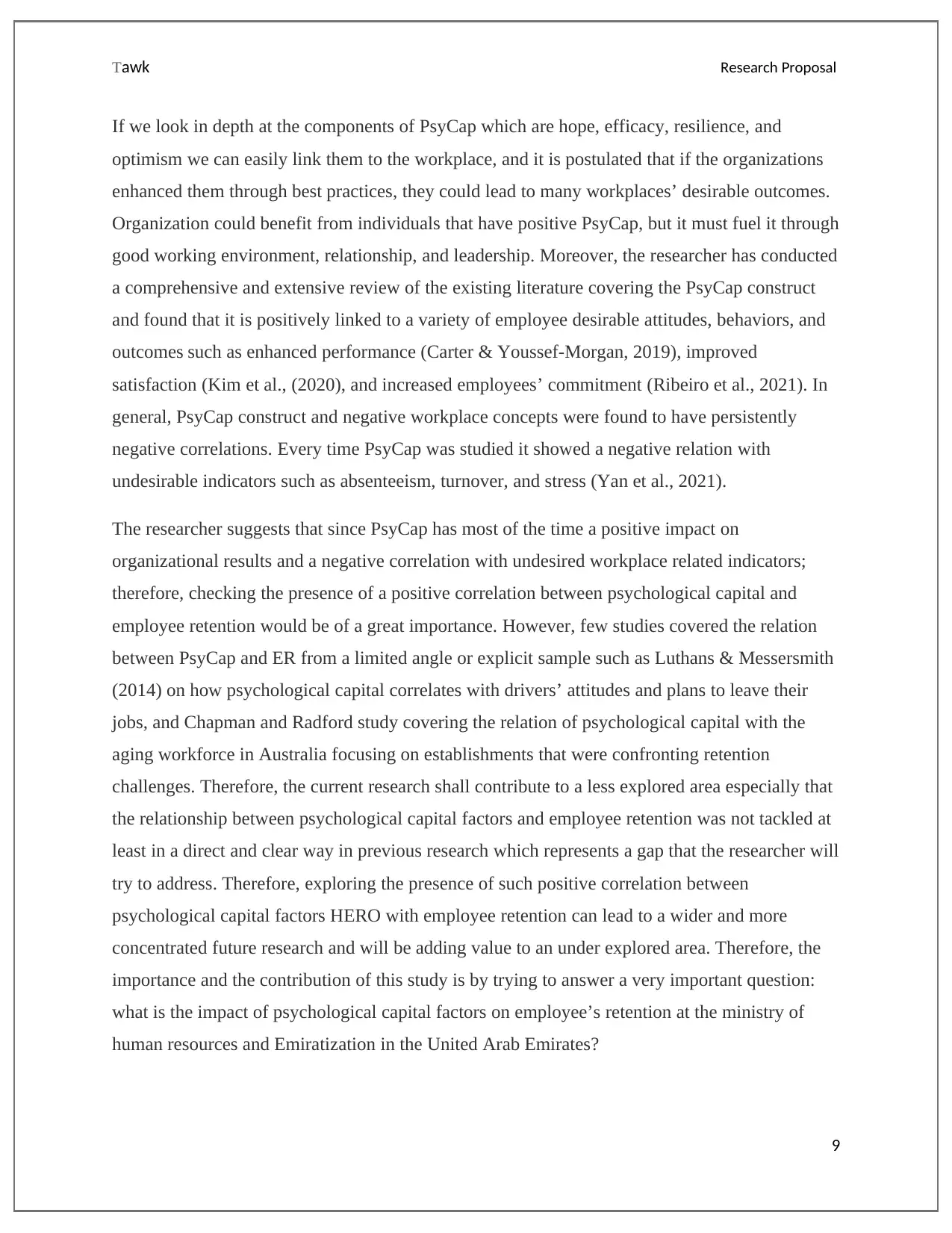
Tawk Research Proposal
If we look in depth at the components of PsyCap which are hope, efficacy, resilience, and
optimism we can easily link them to the workplace, and it is postulated that if the organizations
enhanced them through best practices, they could lead to many workplaces’ desirable outcomes.
Organization could benefit from individuals that have positive PsyCap, but it must fuel it through
good working environment, relationship, and leadership. Moreover, the researcher has conducted
a comprehensive and extensive review of the existing literature covering the PsyCap construct
and found that it is positively linked to a variety of employee desirable attitudes, behaviors, and
outcomes such as enhanced performance (Carter & Youssef‐Morgan, 2019), improved
satisfaction (Kim et al., (2020), and increased employees’ commitment (Ribeiro et al., 2021). In
general, PsyCap construct and negative workplace concepts were found to have persistently
negative correlations. Every time PsyCap was studied it showed a negative relation with
undesirable indicators such as absenteeism, turnover, and stress (Yan et al., 2021).
The researcher suggests that since PsyCap has most of the time a positive impact on
organizational results and a negative correlation with undesired workplace related indicators;
therefore, checking the presence of a positive correlation between psychological capital and
employee retention would be of a great importance. However, few studies covered the relation
between PsyCap and ER from a limited angle or explicit sample such as Luthans & Messersmith
(2014) on how psychological capital correlates with drivers’ attitudes and plans to leave their
jobs, and Chapman and Radford study covering the relation of psychological capital with the
aging workforce in Australia focusing on establishments that were confronting retention
challenges. Therefore, the current research shall contribute to a less explored area especially that
the relationship between psychological capital factors and employee retention was not tackled at
least in a direct and clear way in previous research which represents a gap that the researcher will
try to address. Therefore, exploring the presence of such positive correlation between
psychological capital factors HERO with employee retention can lead to a wider and more
concentrated future research and will be adding value to an under explored area. Therefore, the
importance and the contribution of this study is by trying to answer a very important question:
what is the impact of psychological capital factors on employee’s retention at the ministry of
human resources and Emiratization in the United Arab Emirates?
9
If we look in depth at the components of PsyCap which are hope, efficacy, resilience, and
optimism we can easily link them to the workplace, and it is postulated that if the organizations
enhanced them through best practices, they could lead to many workplaces’ desirable outcomes.
Organization could benefit from individuals that have positive PsyCap, but it must fuel it through
good working environment, relationship, and leadership. Moreover, the researcher has conducted
a comprehensive and extensive review of the existing literature covering the PsyCap construct
and found that it is positively linked to a variety of employee desirable attitudes, behaviors, and
outcomes such as enhanced performance (Carter & Youssef‐Morgan, 2019), improved
satisfaction (Kim et al., (2020), and increased employees’ commitment (Ribeiro et al., 2021). In
general, PsyCap construct and negative workplace concepts were found to have persistently
negative correlations. Every time PsyCap was studied it showed a negative relation with
undesirable indicators such as absenteeism, turnover, and stress (Yan et al., 2021).
The researcher suggests that since PsyCap has most of the time a positive impact on
organizational results and a negative correlation with undesired workplace related indicators;
therefore, checking the presence of a positive correlation between psychological capital and
employee retention would be of a great importance. However, few studies covered the relation
between PsyCap and ER from a limited angle or explicit sample such as Luthans & Messersmith
(2014) on how psychological capital correlates with drivers’ attitudes and plans to leave their
jobs, and Chapman and Radford study covering the relation of psychological capital with the
aging workforce in Australia focusing on establishments that were confronting retention
challenges. Therefore, the current research shall contribute to a less explored area especially that
the relationship between psychological capital factors and employee retention was not tackled at
least in a direct and clear way in previous research which represents a gap that the researcher will
try to address. Therefore, exploring the presence of such positive correlation between
psychological capital factors HERO with employee retention can lead to a wider and more
concentrated future research and will be adding value to an under explored area. Therefore, the
importance and the contribution of this study is by trying to answer a very important question:
what is the impact of psychological capital factors on employee’s retention at the ministry of
human resources and Emiratization in the United Arab Emirates?
9
⊘ This is a preview!⊘
Do you want full access?
Subscribe today to unlock all pages.

Trusted by 1+ million students worldwide
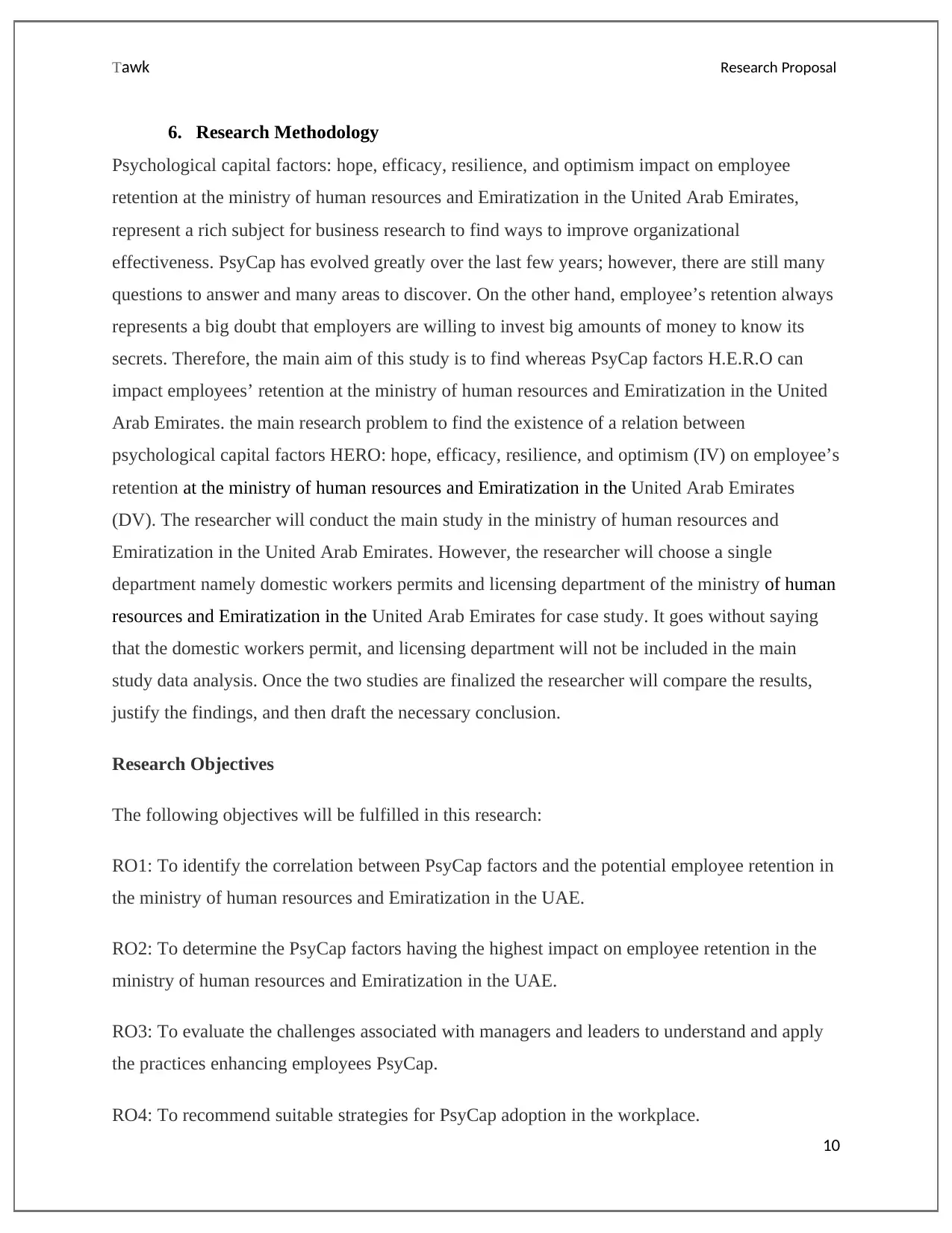
Tawk Research Proposal
6. Research Methodology
Psychological capital factors: hope, efficacy, resilience, and optimism impact on employee
retention at the ministry of human resources and Emiratization in the United Arab Emirates,
represent a rich subject for business research to find ways to improve organizational
effectiveness. PsyCap has evolved greatly over the last few years; however, there are still many
questions to answer and many areas to discover. On the other hand, employee’s retention always
represents a big doubt that employers are willing to invest big amounts of money to know its
secrets. Therefore, the main aim of this study is to find whereas PsyCap factors H.E.R.O can
impact employees’ retention at the ministry of human resources and Emiratization in the United
Arab Emirates. the main research problem to find the existence of a relation between
psychological capital factors HERO: hope, efficacy, resilience, and optimism (IV) on employee’s
retention at the ministry of human resources and Emiratization in the United Arab Emirates
(DV). The researcher will conduct the main study in the ministry of human resources and
Emiratization in the United Arab Emirates. However, the researcher will choose a single
department namely domestic workers permits and licensing department of the ministry of human
resources and Emiratization in the United Arab Emirates for case study. It goes without saying
that the domestic workers permit, and licensing department will not be included in the main
study data analysis. Once the two studies are finalized the researcher will compare the results,
justify the findings, and then draft the necessary conclusion.
Research Objectives
The following objectives will be fulfilled in this research:
RO1: To identify the correlation between PsyCap factors and the potential employee retention in
the ministry of human resources and Emiratization in the UAE.
RO2: To determine the PsyCap factors having the highest impact on employee retention in the
ministry of human resources and Emiratization in the UAE.
RO3: To evaluate the challenges associated with managers and leaders to understand and apply
the practices enhancing employees PsyCap.
RO4: To recommend suitable strategies for PsyCap adoption in the workplace.
10
6. Research Methodology
Psychological capital factors: hope, efficacy, resilience, and optimism impact on employee
retention at the ministry of human resources and Emiratization in the United Arab Emirates,
represent a rich subject for business research to find ways to improve organizational
effectiveness. PsyCap has evolved greatly over the last few years; however, there are still many
questions to answer and many areas to discover. On the other hand, employee’s retention always
represents a big doubt that employers are willing to invest big amounts of money to know its
secrets. Therefore, the main aim of this study is to find whereas PsyCap factors H.E.R.O can
impact employees’ retention at the ministry of human resources and Emiratization in the United
Arab Emirates. the main research problem to find the existence of a relation between
psychological capital factors HERO: hope, efficacy, resilience, and optimism (IV) on employee’s
retention at the ministry of human resources and Emiratization in the United Arab Emirates
(DV). The researcher will conduct the main study in the ministry of human resources and
Emiratization in the United Arab Emirates. However, the researcher will choose a single
department namely domestic workers permits and licensing department of the ministry of human
resources and Emiratization in the United Arab Emirates for case study. It goes without saying
that the domestic workers permit, and licensing department will not be included in the main
study data analysis. Once the two studies are finalized the researcher will compare the results,
justify the findings, and then draft the necessary conclusion.
Research Objectives
The following objectives will be fulfilled in this research:
RO1: To identify the correlation between PsyCap factors and the potential employee retention in
the ministry of human resources and Emiratization in the UAE.
RO2: To determine the PsyCap factors having the highest impact on employee retention in the
ministry of human resources and Emiratization in the UAE.
RO3: To evaluate the challenges associated with managers and leaders to understand and apply
the practices enhancing employees PsyCap.
RO4: To recommend suitable strategies for PsyCap adoption in the workplace.
10
Paraphrase This Document
Need a fresh take? Get an instant paraphrase of this document with our AI Paraphraser
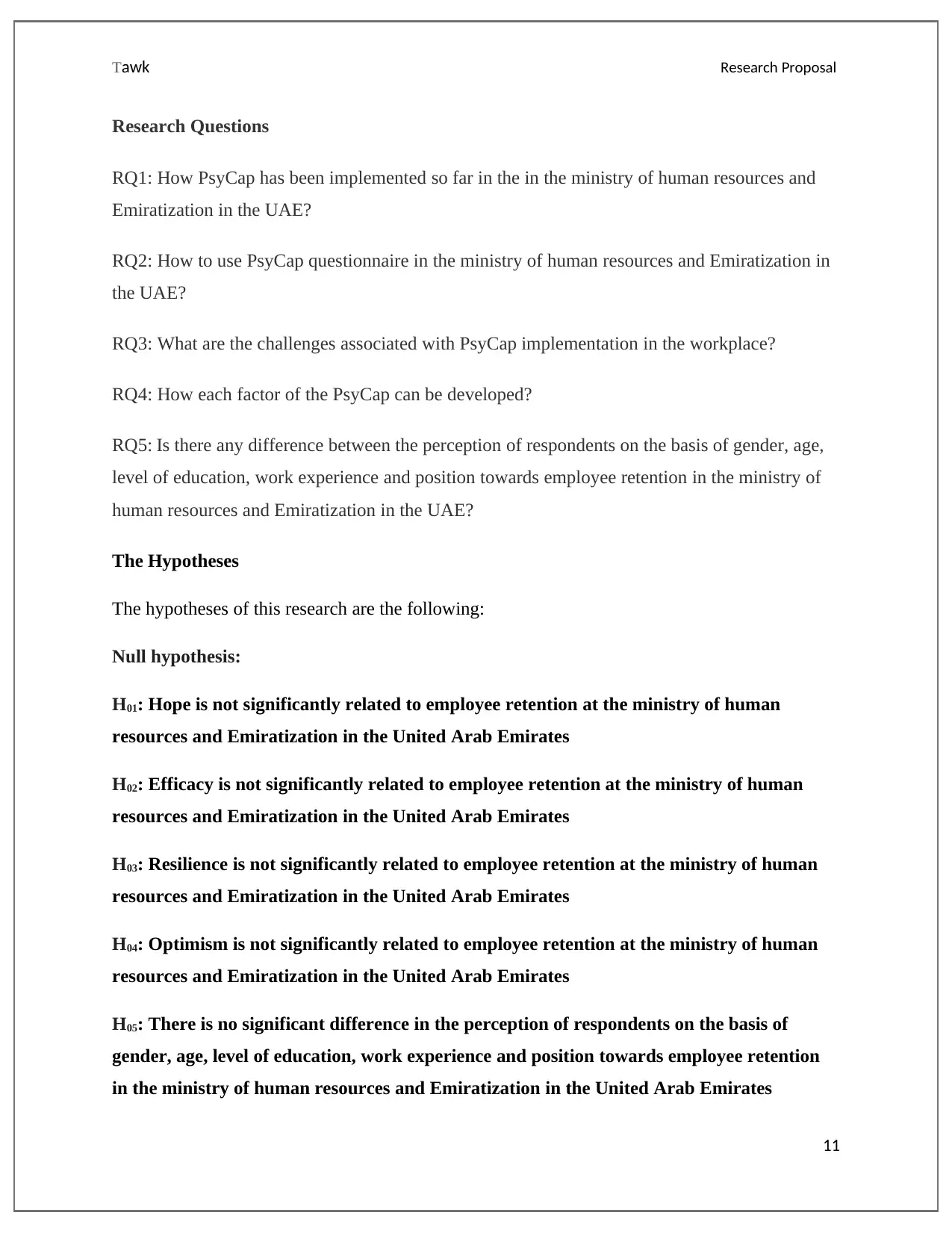
Tawk Research Proposal
Research Questions
RQ1: How PsyCap has been implemented so far in the in the ministry of human resources and
Emiratization in the UAE?
RQ2: How to use PsyCap questionnaire in the ministry of human resources and Emiratization in
the UAE?
RQ3: What are the challenges associated with PsyCap implementation in the workplace?
RQ4: How each factor of the PsyCap can be developed?
RQ5: Is there any difference between the perception of respondents on the basis of gender, age,
level of education, work experience and position towards employee retention in the ministry of
human resources and Emiratization in the UAE?
The Hypotheses
The hypotheses of this research are the following:
Null hypothesis:
H01: Hope is not significantly related to employee retention at the ministry of human
resources and Emiratization in the United Arab Emirates
H02: Efficacy is not significantly related to employee retention at the ministry of human
resources and Emiratization in the United Arab Emirates
H03: Resilience is not significantly related to employee retention at the ministry of human
resources and Emiratization in the United Arab Emirates
H04: Optimism is not significantly related to employee retention at the ministry of human
resources and Emiratization in the United Arab Emirates
H05: There is no significant difference in the perception of respondents on the basis of
gender, age, level of education, work experience and position towards employee retention
in the ministry of human resources and Emiratization in the United Arab Emirates
11
Research Questions
RQ1: How PsyCap has been implemented so far in the in the ministry of human resources and
Emiratization in the UAE?
RQ2: How to use PsyCap questionnaire in the ministry of human resources and Emiratization in
the UAE?
RQ3: What are the challenges associated with PsyCap implementation in the workplace?
RQ4: How each factor of the PsyCap can be developed?
RQ5: Is there any difference between the perception of respondents on the basis of gender, age,
level of education, work experience and position towards employee retention in the ministry of
human resources and Emiratization in the UAE?
The Hypotheses
The hypotheses of this research are the following:
Null hypothesis:
H01: Hope is not significantly related to employee retention at the ministry of human
resources and Emiratization in the United Arab Emirates
H02: Efficacy is not significantly related to employee retention at the ministry of human
resources and Emiratization in the United Arab Emirates
H03: Resilience is not significantly related to employee retention at the ministry of human
resources and Emiratization in the United Arab Emirates
H04: Optimism is not significantly related to employee retention at the ministry of human
resources and Emiratization in the United Arab Emirates
H05: There is no significant difference in the perception of respondents on the basis of
gender, age, level of education, work experience and position towards employee retention
in the ministry of human resources and Emiratization in the United Arab Emirates
11
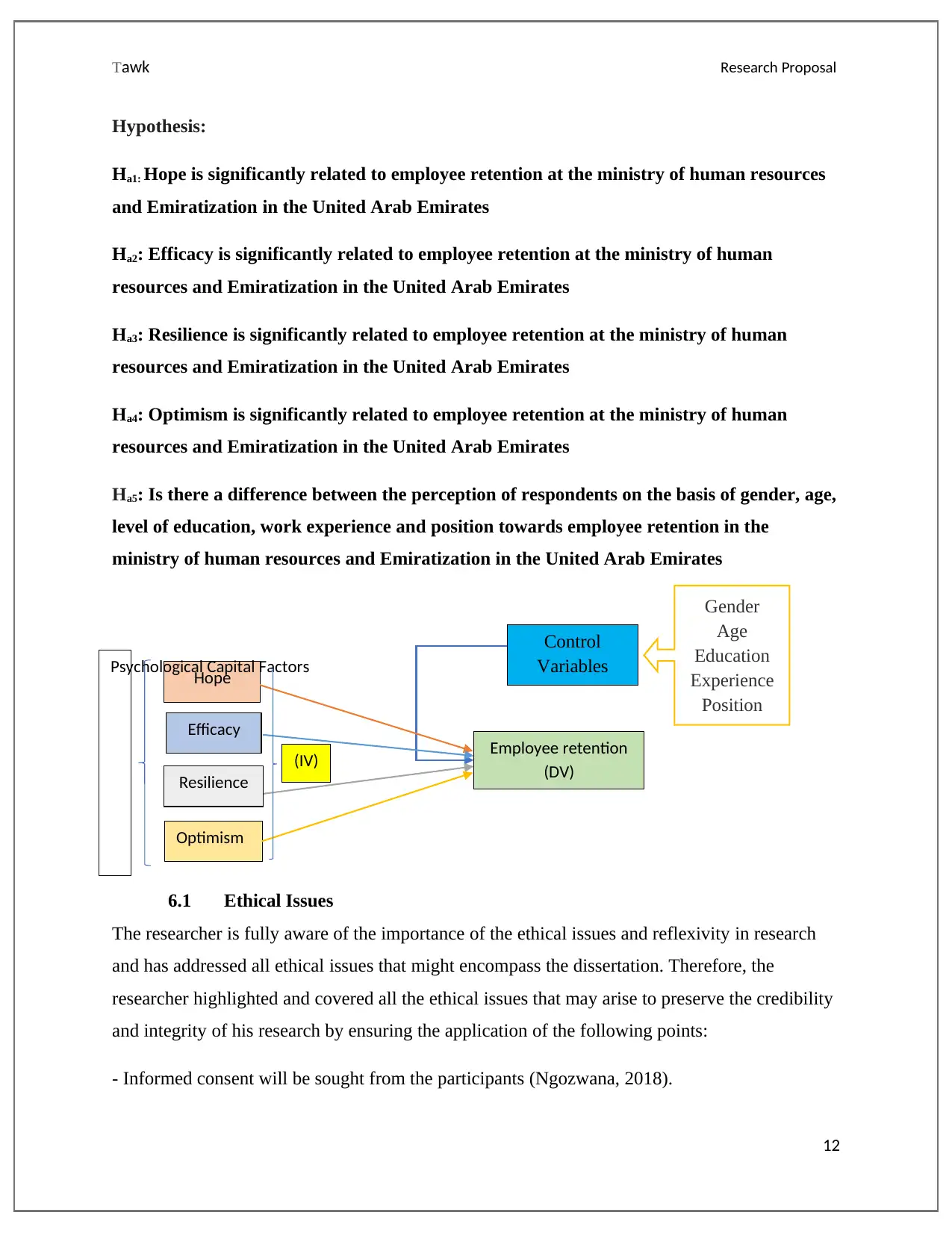
Tawk Research Proposal
Hypothesis:
Ha1: Hope is significantly related to employee retention at the ministry of human resources
and Emiratization in the United Arab Emirates
Ha2: Efficacy is significantly related to employee retention at the ministry of human
resources and Emiratization in the United Arab Emirates
Ha3: Resilience is significantly related to employee retention at the ministry of human
resources and Emiratization in the United Arab Emirates
Ha4: Optimism is significantly related to employee retention at the ministry of human
resources and Emiratization in the United Arab Emirates
Ha5: Is there a difference between the perception of respondents on the basis of gender, age,
level of education, work experience and position towards employee retention in the
ministry of human resources and Emiratization in the United Arab Emirates
6.1 Ethical Issues
The researcher is fully aware of the importance of the ethical issues and reflexivity in research
and has addressed all ethical issues that might encompass the dissertation. Therefore, the
researcher highlighted and covered all the ethical issues that may arise to preserve the credibility
and integrity of his research by ensuring the application of the following points:
- Informed consent will be sought from the participants (Ngozwana, 2018).
12
Hope
Efficacy
Resilience
Optimism
Employee retention
(DV)
Psychological Capital Factors
(IV)
Control
Variables
Gender
Age
Education
Experience
Position
Hypothesis:
Ha1: Hope is significantly related to employee retention at the ministry of human resources
and Emiratization in the United Arab Emirates
Ha2: Efficacy is significantly related to employee retention at the ministry of human
resources and Emiratization in the United Arab Emirates
Ha3: Resilience is significantly related to employee retention at the ministry of human
resources and Emiratization in the United Arab Emirates
Ha4: Optimism is significantly related to employee retention at the ministry of human
resources and Emiratization in the United Arab Emirates
Ha5: Is there a difference between the perception of respondents on the basis of gender, age,
level of education, work experience and position towards employee retention in the
ministry of human resources and Emiratization in the United Arab Emirates
6.1 Ethical Issues
The researcher is fully aware of the importance of the ethical issues and reflexivity in research
and has addressed all ethical issues that might encompass the dissertation. Therefore, the
researcher highlighted and covered all the ethical issues that may arise to preserve the credibility
and integrity of his research by ensuring the application of the following points:
- Informed consent will be sought from the participants (Ngozwana, 2018).
12
Hope
Efficacy
Resilience
Optimism
Employee retention
(DV)
Psychological Capital Factors
(IV)
Control
Variables
Gender
Age
Education
Experience
Position
⊘ This is a preview!⊘
Do you want full access?
Subscribe today to unlock all pages.

Trusted by 1+ million students worldwide
1 out of 29
Your All-in-One AI-Powered Toolkit for Academic Success.
+13062052269
info@desklib.com
Available 24*7 on WhatsApp / Email
![[object Object]](/_next/static/media/star-bottom.7253800d.svg)
Unlock your academic potential
Copyright © 2020–2025 A2Z Services. All Rights Reserved. Developed and managed by ZUCOL.